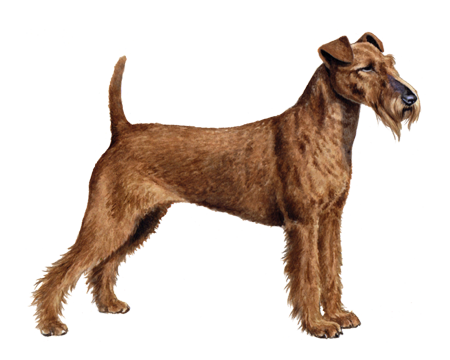
Irish Terrier
Irish Terriers are charming, loyal, and affectionate dogs that like to please. They're known for their fiery and boisterous personalities and determination as working dogs. At home, Irish Terriers make sensitive family companions.
Interested in discovering if your dog is an Irish Terrier?
Check out Wisdom Panel's DNA tests.

Irish Terrier Traits
General Appearance
The Irish Terrier is solid in stature, but also agile and elegant. The breed is moderately long in the body with shoulders that slope into its back. Its chest is distinctly deep and muscular.
Coat and Coloring
The Irish Terrier has a dense and wiry coat that comes in bright red, golden, red wheaten, or wheaten. A small patch of white is sometimes visible on the dog's chest. Though Irish Terriers are born with black hairs, these lighten to the standard color as the dogs age.
Distinctive Physical Traits
There's a noticeable uniformity to the Irish Terrier's appearance. It has a long head, strong and muscular jaws, forward-folding ears, and smiling eyes.
Irish Terrier Temperament
Irish Terriers are energetic dogs that need consistent challenges for both their mental and physical health. They are full of life but not particularly hyper.
Loyal companions that get along well with people of all ages, Irish Terriers make decent watch dogs. But they may be reserved around strangers.
This breed can sometimes be reactive to other dogs and may chase wildlife. Other behaviors to watch out for are barking and digging. Because of their working dog backgrounds, Irish Terriers can be hard to distract once they're engaged in an activity.


Irish Terrier History
Irish Terriers got their start in Cork, Ireland, during the 1870s when the first breed club formed. Their exact origin is unknown, though many experts believe they descended from the Black-and-Tan Irish Terrier. Regardless, the Irish Terrier was the first native Irish breed to be recognized by the English Kennel Club.
During World War I, Irish Terriers served as couriers to carry messages to the front. They also received commendations during the war for locating wounded soldiers. F. M. Jowett, an English writer, described them as "the poor man's sentinel, the farmer's friend, and the gentleman's favorite."
By the 1880s, the Irish Terrier was the fourth most popular breed in England—and that popularity quickly spread to the United States. The American Kennel Club recognized the breed in 1885. And the Irish Terrier Club of America formed in 1896.
Irish Terrier Care
Nutrition
You should feed your Irish Terrier a high-quality dog food that's appropriate for their life stage (e.g., puppy, adult, senior) and activity level.
All dogs run the risk of obesity if they consume too many calories. So, keep an eye on the amount of food you give your Irish Terrier, and reduce the portions if your pup gains weight. Also, remember that giving too many treats in addition to regular meals can contribute to obesity.
Grooming
Regular brushing, stripping, and trimming are a must to keep the Irish Terrier's coat looking its best. The dog's outer coat should be hand-stripped rather than clipped, if possible. If done weekly, brushing helps remove dirt and loose hair. And keeping your dog's nails trimmed short will prevent discomfort or issues walking.
Exercise
Energetic dogs, Irish Terriers are always up for some fun. They need regular exercise, and romps in a fenced backyard are a great way for them to burn energy. Walking is another good activity, provided they get out several times a day—and always on a leash. These athletic dogs also enjoy field trials, hunting, agility, tracking, and competitive obedience.
Training
Although they are incredibly smart dogs, Irish Terriers are strong-willed and have an independent streak. (They are terriers, after all.) These characteristics can make training a challenge. Though this breed enjoys learning and mastering new tasks, reward-based training using toys and treats as motivation will make sessions easier.
Early socialization and basic obedience classes will help Irish Terriers develop into well-mannered adult dogs. Remember that consistent training is a lifelong endeavor for these dogs.

Irish Terrier Genetic Health Conditions
-
Darier Disease (Discovered in the Irish Terrier)
Darier Disease is a skin disorder characterized by cysts forming in the skin or ear canals that can be covered by ulcerative lesions. The associated genetic variant has been identified in the Irish Terrier.
-
Hereditary Footpad Hyperkeratosis
Hereditary Footpad Hyperkeratosis (HFH) is a skin disorder, with disease signs including hard, thickened, and cracked footpads and an abnormal coat.
Knowing if your Irish Terrier is a carrier or at-risk for these conditions can help you and your veterinarian plan for your pup’s lifelong care. With Wisdom Panel™ Premium, you can get results for over 200 genetic health tests.
Breed Group
Terrier
The Terrier Group ancestors were bred to hunt and kill vermin. They are often characterized as feisty and energetic dogs whose sizes range from fairly small to much larger.
Resources
https://www.akc.org/dog-breeds/irish-terrier/
Reviewed July 26, 2020 by Cindy Elston, DVM, MPH
































































